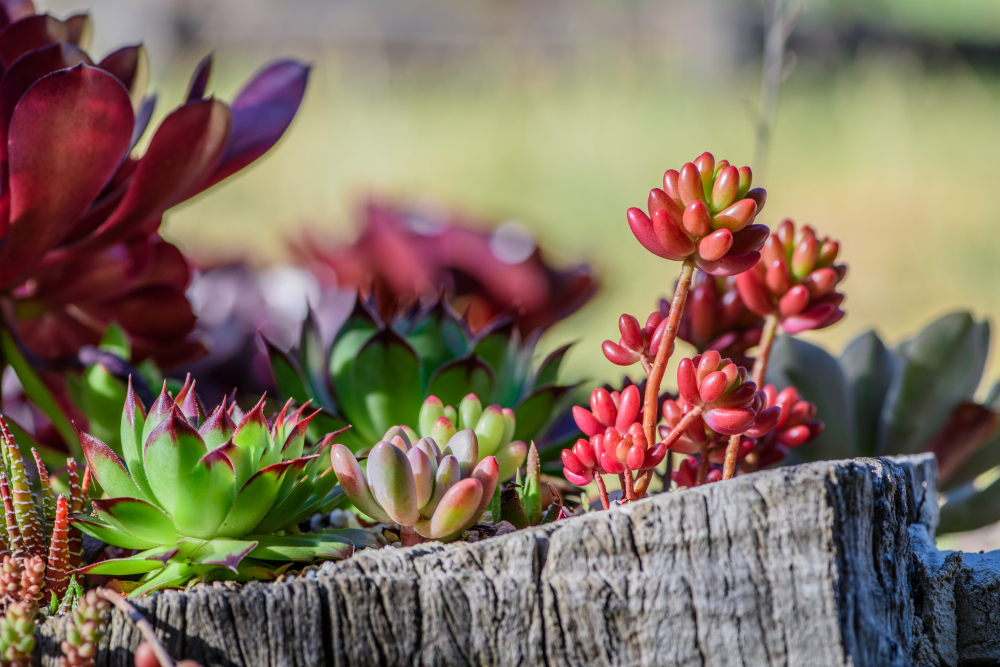
Succulents have been reigning supreme on the Australian plant scene, and hybrid succulents lead the pack! They rarely fail to turn heads and often can brighten your living spaces. These gorgeous plants aren't just hardy and low-maintenance, but they also come in a range of leaf shapes, bright colours, and unique textures.
What are hybrid succulents?
In simple terms, hybrid succulents are crossbred succulents, where two or more succulents are hybridised to create something unique and new. In most cases, you can readily hybridise plants that are within the same genus, which are called interspecific hybrids. However, if you cross two individual plants from two different genera, these are called an Intergenic hybrid and are often indicated with a multiplication sign (×) before the genus name. Usually, hybrids are sterile, which means they don't produce seeds and only propagate by division.
Now, you might wonder how they crossbreed succulents.
The process involves cross-pollinating one succulent species with the pollen of another. This is typically done when both species flower simultaneously. Once they do, a small, soft paintbrush or a cotton bud is used to gather pollen from one flower and transfer it to the other succulent flower. Once the pollination process is completed, the hybrid seeds are formed, carrying a unique mix of traits from the parent plants. The seeds are then planted, and a new hybrid succulent begins to grow.
In Australia, hybrid succulents are very popular due to their high adaptability to varied climate zones. Most succulent hybrids are also perfect for those who are just beginning to include more plants in their indoor or outdoor surrounding.
Let's dive deeper into why hybrid succulents are so popular and list some of the best and most gorgeous-looking hybrid succulents suitable for Australian climates.
What makes hybrid succulents so popular?
You might find attractive hybrid popular succulents adorning trendy cafes in Melbourne or sun-kissed balconies along the streets of Brisbane. But what drives this growing popularity? Let's find out!
Unique Shapes and Textures: Most hybrid succulents that have inherited the features of both parents often have a kaleidoscope-like appearance due to their variegated leaf shapes and contrasting colours.
For example, there are rosettes with swirls of pink, mint green and lavender, or there are plump leaves that look like dolphins and hearts. These unique succulent combinations create new visual delights that can uplift boring spaces.
Versatile for Any Space: Whether you want to plant them in your garden bed or style a coffee table, succulent hybrids fit just about perfectly into any space. Their size and structure range from small, table or desk-friendly pots to garden-worthy displays. As they don't require constant and direct sun or daily watering, they are also perfect for some well-lit indoor gardens like balconies or shaded patios.
Types of Hybrid Succulents You Should Know
Here are some popular hybrid succulents that are beginner-friendly and loved by Australian plant lovers.
1. Graptoveria:
This hybrid is a cross between Graptopetalum and Echeveria, known for their pastel rosettes and thick leaves. They look beautiful for both pots and hanging baskets.
2. Echeveria Hybrids:
Echeveria Hybrids are one of the most common hybrids. Varieties like 'Perle von Nurnberg' or 'Lola' are often spotted in home décor setups. Their soft hues and symmetrical form make them a favourite of many plant enthusiasts.
3. Sedeveria:
The Sedeveria is a hybrid between Sedum and Echeveria. They grow fast and are a great option if you want a fuller display.
4. Pachyveria:
Pachyveria is a hybrid combining Echeveria and Pachyphytum. They exhibit chunky, colourful leaves and often show hints of pink and blue at the edges. They also love the outdoor Aussie sun and, hence, a great addition to your garden.
5. Aeonium Hybrids:
Aeonium Hybrids are less common but visually stunning succulents. Their long stems and rosette tops show dark burgundy or lime-green tones that add a bold flair to your garden.
Rare Succulent Hybrids That Enthusiasts Adore
If you are a plant collector or love the idea of having something unique in your green space, then these succulents are worth exploring. These rare succulent hybrids are harder to find and have an expensive variety, but they are priced for their uniqueness and their beauty.
Here are some standout favourites:
Echeveria Rainbow: One of the most popular rare succulents among collectors, these come in rosettes with multi-toned pastel colours.
Graptoveria' Debbie Cristata': These showpieces of the Debbie succulent are known for their unique fan-like growth pattern that is formed due to its mutation called cresting. They have a bluish-purple colour, and they have a tendency to develop pink tips when they are under stress.
Pachyveria' Blue Mist': These compact stemless hybrids are blue-grey in appearance. Due to their powdery, whitish coating (Farina), they have a frosty appearance and are great pieces for your window sill.
Variegated Aeoniums: These are stunning hybrids that have marbled, multi-coloured leaves and are considered a collector's item.
Succulent Hybrid Varieties for Every Space
Here are top picks that fit perfectly into your homes, offices or your garden.
Best succulents for Indoor Gardens:
Graptoveria' Fred Ives': They are great when placed by a window sill as they can tolerate bright, indirect light.
Echeveria' Dionysus': Due to their. Compact and colourful in appearance, they are ideal for desks or smaller spaces.
For bathrooms or Low-light Corners:
Sedeveria' Letizia: These are less tolerant of light and hence can be placed in the bathroom or dark corners.
Pachyveria' Glauca': It has a calm blue appearance and can sustain without sunlight, making it ideal for dark spaces.
For Balcony Pots or Outdoor Beds:
Aeonium' Zwartkop': They grow to a moderate height and thrive in sunlight. Their dark, glossy rosettes prefer full sun exposure, but during hot climates, they may do well in some afternoon shade.
Sedeveria' Jet Beads': Their dark leaves add contrast when paired with lighter plants, and they thrive well outdoors.
Tips for Beginners while Cross-breeding Succulents
• When you are trying to transfer pollen from one flower to another, use a clean, soft brush or cotton swab to transfer.
• Choose two healthy parent succulents whose traits and colours you love
• Be patient, as germination can take weeks.
• Use well-draining soil when you are planting the germinated seed
• Water only when you notice that the soil is completely dry.
• Try and place hybrids in bright, indirect light rather than direct harsh sun.
• To recognise hybrid succulent types, you can use succulent plant identification apps like PlantNet or PlantSnap
Follow our Instagram Page for more tips on Succulents, other plant species and care guides for beginners!
Most of the common succulents are readily available for purchase in Australian online plant marketplaces. Bring these conversation starters into your homes and gardens. Succulents are generally low-fuss, extremely attractive and make for great centrepieces on your desk or tea table.
Visit PlantArk's Blog Page for more information on succulents and plant-care tips.
PlantArk is an online marketplace in Australia where you can buy and sell plants and seeds with a few easy steps!


